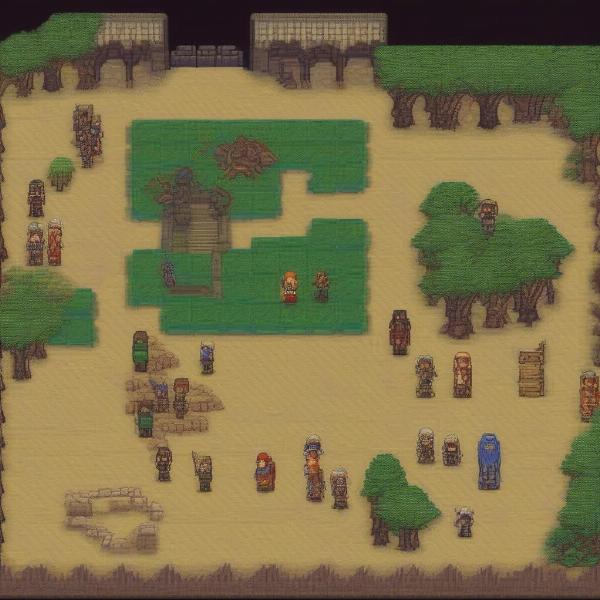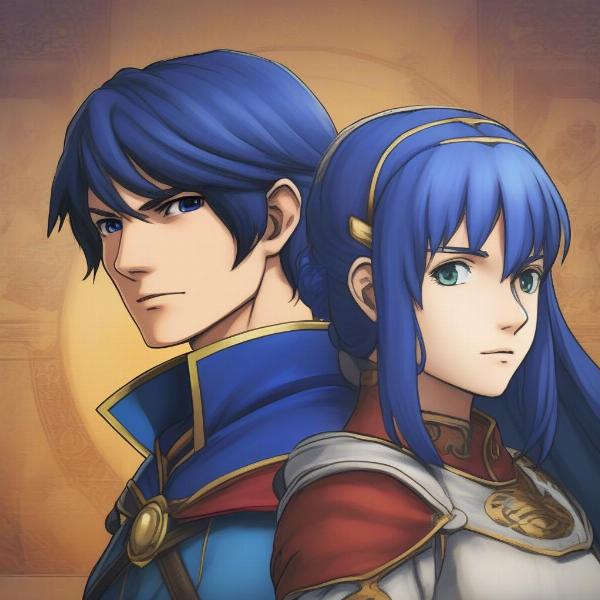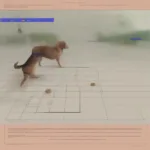Fire Emblem’s legacy spans decades, but What Was The First Fire Emblem Game? Released in 1990 for the Famicom in Japan, Fire Emblem: Shadow Dragon and the Blade of Light introduced the world to strategic role-playing with permadeath. This groundbreaking title laid the foundation for the beloved franchise we know today.
Unveiling the Origins: Fire Emblem: Shadow Dragon and the Blade of Light
Shadow Dragon and the Blade of Light followed the journey of Prince Marth as he fought to reclaim his kingdom and the sacred Falchion blade. The game’s innovative blend of turn-based tactical combat and character-driven narrative captivated players. While initially exclusive to Japan, Shadow Dragon‘s influence resonated throughout the gaming world, paving the way for future installments. Its mechanics, including the weapon triangle and permadeath system, became hallmarks of the series. Imagine the tension as you moved your units across the grid, knowing one wrong move could result in permanent loss! This added a layer of strategic depth rarely seen in RPGs at the time.
The game’s narrative, centered around Marth’s quest for justice and the restoration of his homeland, resonated with players. It wasn’t just about moving units on a board; it was about forging alliances, making difficult choices, and experiencing the triumphs and losses of war.
The Impact of Shadow Dragon and the Blade of Light
Shadow Dragon‘s success wasn’t just about gameplay; it also introduced a cast of memorable characters who became fan favorites. Marth, the valiant prince, Caeda, the pegasus knight, and Jagen, the seasoned paladin, are just a few examples of the compelling characters that populated the game’s world. These characters, each with their unique backstories and motivations, contributed to the rich tapestry of the game’s narrative, making it more than just a strategic exercise.
The innovative permadeath system, while sometimes frustrating, added a level of realism and consequence to every decision. Players had to carefully consider each move, as losing a beloved unit could have significant repercussions on the battlefield and the overall story. This innovative mechanic, while controversial to some, became a defining characteristic of the series.
 Fire Emblem Shadow Dragon and the Blade of Light Gameplay on Famicom
Fire Emblem Shadow Dragon and the Blade of Light Gameplay on Famicom
Why Shadow Dragon and the Blade of Light Remains Important
Even today, Shadow Dragon and the Blade of Light holds a special place in the hearts of Fire Emblem fans. It’s not just a nostalgic throwback; it represents the genesis of a beloved franchise. Understanding its origins provides valuable context for appreciating the evolution of the series. It’s fascinating to see how the core mechanics and narrative themes established in Shadow Dragon have been iterated upon and refined in subsequent games.
The game’s legacy extends beyond its gameplay and narrative. It influenced the development of numerous tactical RPGs that followed, solidifying its place as a pioneer in the genre. Shadow Dragon established a formula that many games have emulated and expanded upon, but few have captured the same magic.
 Fire Emblem Shadow Dragon Characters Marth and Caeda
Fire Emblem Shadow Dragon Characters Marth and Caeda
The Journey from 8-bit to Modern Consoles: Fire Emblem’s Evolution
From the 8-bit graphics of the Famicom to the stunning visuals of modern consoles, Fire Emblem has come a long way. While the core gameplay mechanics have remained consistent, each new installment has brought its unique innovations and enhancements. The series has experimented with different art styles, expanded the narrative scope, and introduced new gameplay features, all while staying true to the spirit of Shadow Dragon.
The transition from 2D sprites to 3D models, the addition of support conversations and character pairings, and the introduction of new classes and abilities have all contributed to the evolution of the Fire Emblem experience. Despite these changes, the core principles of tactical combat, character development, and compelling storytelling have remained at the heart of the franchise.
Frequently Asked Questions about the First Fire Emblem Game
Q: Was Fire Emblem: Shadow Dragon and the Blade of Light released outside Japan initially?
A: No, it was initially a Japan-exclusive release for the Famicom.
Q: Who is the main character in the first Fire Emblem game?
A: Prince Marth is the main protagonist of Shadow Dragon and the Blade of Light.
Q: What makes Fire Emblem’s gameplay unique?
A: The blend of tactical RPG combat and permadeath creates a uniquely challenging and engaging experience.
Q: How has the Fire Emblem series evolved over time?
A: From improved graphics and sound to expanded gameplay mechanics and storytelling, the series has continually innovated while staying true to its core principles.
Q: Why is knowing about Shadow Dragon important for Fire Emblem fans?
A: Understanding the origins of the series provides context for appreciating its evolution and the enduring appeal of its core themes and mechanics.
Q: What is the significance of the “weapon triangle” in Fire Emblem?
A: The weapon triangle (swords beat axes, axes beat lances, lances beat swords) adds a layer of strategic depth to combat.
Q: Is permadeath always a feature in Fire Emblem games?
A: While a defining characteristic, some later games offer “casual mode” as an alternative to permadeath.
In conclusion, Fire Emblem: Shadow Dragon and the Blade of Light marked the beginning of a legendary tactical RPG franchise. While it may appear dated by today’s standards, its impact on the genre is undeniable. It’s a must-play for any Fire Emblem fan eager to explore the roots of the series and witness the birth of a legend. What are your thoughts on the first Fire Emblem game? Share your experiences and opinions in the comments below!
